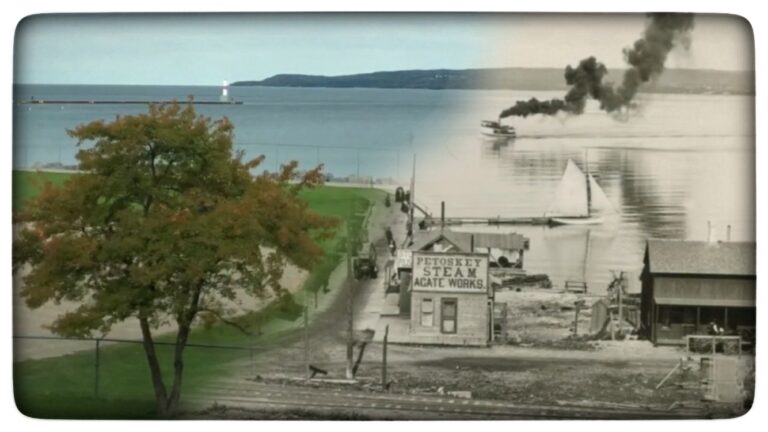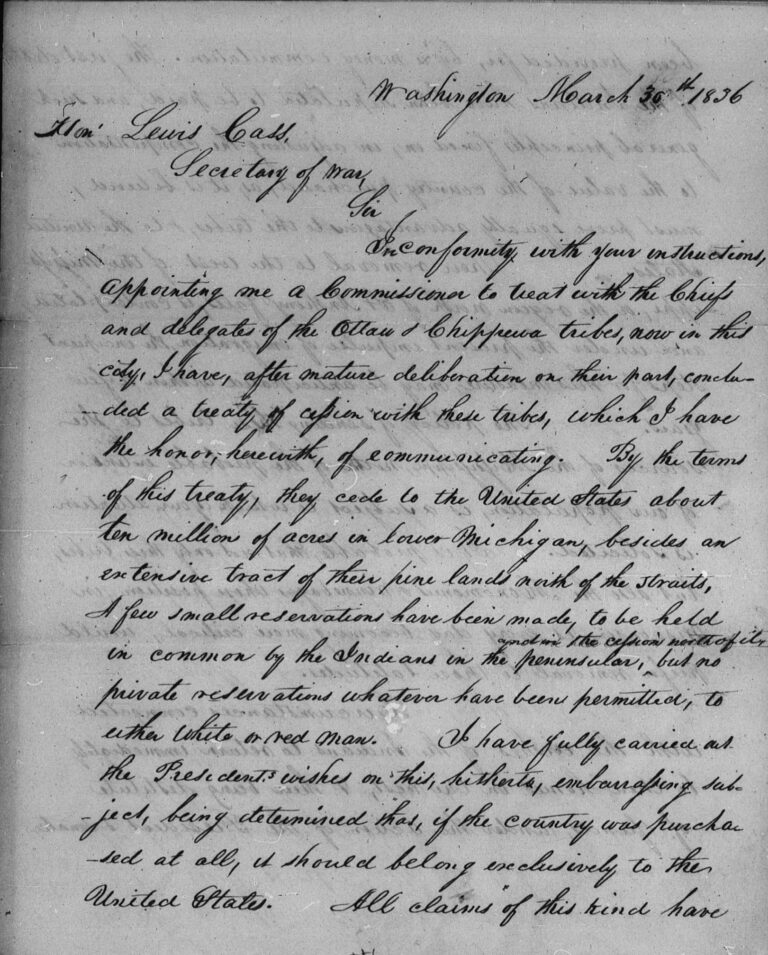The Transformation of petoskey:
Physical, Cultural, Economic, and social change.

TimeShift from Petoskey Harbor - 1890
This lesson explores how the land around Petoskey is transformed from a resource rich area inhabited by Native Americans to a bustling tourist city that still honors its roots.
This TimeShift starts in 1890, then moves the viewer through history. On this journey we will explore life in the area as it is transformed by the flow of people seeking to enjoy and profit off the abundant natural resources. Petoskey, Michigan attracted settlers and entrepreneurs who transformed a land once occupied by the Odawa (Ottawa), a Native American nation of hunters, farmers, and traders.
Negotiated treaties opened up the land for purchase, and with the growing population of newcomers, the land and its people would also become transformed. Initially, French fur traders interacted and traded pelts with the First Peoples of the area, and then came religious missionaries preaching Christianity.
Businessman Hiram Rose found wealth in the California Gold Rush. He was on his way to investigate copper mining options in Michigan when he discovered Bear Creek, a small town on Little Traverse Bay. He stayed and grew the small town into the city it is today. One of his first projects was a commercial grade dock. He later founded the Petoskey Limestone Company, which provided for brick and mortar construction as the city expanded. These structures fill the city to this day.
The railroad tracks from Chicago and Grand Rapids end in Petoskey. The Lumberjacks made certain the trains and ships were loaded with lumber. The ladies of Petoskey organized for a World War and gained the right to vote soon thereafter.
Despite the original upheaval of both the indigenous communities and the old growth pines, the forests continue to thrive and many Native American traditions are still practiced there today.
Quick Facts
Originally called Bear Creek, Petoskey was named after the Odawa tribal Chief Petosega.
The Odawa were first encountered by European explorers in 1615. In the early 1800s, missionaries, then timber prospectors, made their way to the unspoiled land of Northern Michigan. The missionaries came looking for Native People to receive their message of Christianity. The lumber prospectors were looking for pine forests to fell. The transformation of northern Michigan had begun.
There are about 10,000 Odawa currently living in the United States, the majority of whom live in the northwest corner of Michigan.
The pine of Michigan made more millionaires than the gold of California.
The Petoskey Stone has been the official state stone of Michigan since 1965. The fossilized coral in the limestone rock resembles rays of sunshine. Collecting these unique stones has been a long held custom for tourists walking the northern Michigan shoreline.
The Petoskey Pierhead Lighthouse was first established in 1899. The current automated lighthouse is a forty foot high white and red cylindrical tower. It is used to aid mariners as they enter into the Petoskey Harbor.
Nobel and Pulitzer Prize winning author Ernest Hemingway spent many of his childhood summers in the Petoskey area. His ”Nick Adams” series is set in Northwest Michigan. The Michigan Hemingway Society, at their 2017 annual conference, unveiled a statue of the author in Petoskey’s Pennsylvania Park.
treaties
The United States government signed many treaties with the Indigenous Peoples of North America. In Michigan there were 11 treaties which resulted in the Native Americans giving up rights to the land. These treaties were often one-sided, with the vast majority of the benefits going to the United States government. Some of these treaties are still being litigated in Michigan courtrooms to this day.
It was the Treaty of Washington, signed in 1836 by President Andrew Jackson and representatives of the Odawa and Chippewa nations of Native Americans, that saw 13,837,207 acres or about 37% of Michigan being ceded from the Native Americans to the United States federal government.
Below is a portion of a letter written by the federal agent Harry Schoolcraft to Michigan Territorial Governor Lewis Cass, that indicates the Indigenous People had agreed to give up “Ten million of acres in lower Michigan”.
Within the ceded land was Bear Creek, the community that is now known as Petoskey. Click the image below to view the original 1836 Treaty of Washington and various supporting documents.
holy childhood school
The Holy Childhood School was a boarding school in Harbor Springs, a small town across the bay from Petoskey. Many of these government funded boarding schools were constructed across the United States and Canada in the late 1800s. These schools were intended to eliminate the cultural practices of Native American children, and assimilate them into modern North American society. Many of the children were forced to convert to Christianity and were not allowed to speak their native languages. They received basic education, math and English, they also received skills training such as farming, housekeeping and manual labor.
Most of these schools were shut down in the 1920s, but one managed to carry on until it was finally forced to close in the 1980s. Click here to view a slideshow, read an article and listen to a Michigan Public Radio broadcast regarding the Holy Childhood School.
Click the video below to watch a brief interview discussing the benefits and harm caused by schools like The Holy Childhood School in Harbor Springs.
lOGGING CULTURE
During the 19th century, the lumber industry thrived from Maine to Minnesota. Forests of White Pine, found throughout Michigan, grew straight and tall. As a lightweight and easy to nail hardwood, it was in high demand as a building material of the time.
Michigan logging towns came and went. One such town was Singapore, located at the mouth of the Kalamazoo River, north of Saugatuck. The town disappeared in 1875 as a result of erosion from clear cutting. Following the drought and the Great Lakes fires of 1871, the trees around Singapore were cut and sent to Chicago and elsewhere, to help cities rebuild. Within only a few years, the Westerly winds blowing in from Lake Michigan completely covered the once thriving logging town with sand – erasing it from the maps. It remains under sand to this day.
By hand, and later with steam powered tools, vast forests were brought down and usable lumber was shipped across the country by rail and water. Large areas of Michigan were left barren, until the 1930s, when the young men of the Civilian Conservation Corps planted seedling trees across the state.
With lumber barons buying up tracts of Michigan’s forests, hordes of men looking for work relocated to the area. They lived as a community in logging camps, and an American subculture of woodsmen and lumberjacks was created.
Living and working together, they developed their own forms of communication, which was rich in colorful terms and jargon specific to their rugged lumber camp life. Some of their terms are well-known even today. “Haywire” was the so-called duct tape of the time, and used to fix broken items. Click here for a guide to Logging Terminology.
Shanties were folk songs that were once commonly sung as a work song to accompany rhythmical labor. More commonly associated with sailors, shanties were also popular with loggers.
The following shanty, “Michigan-I-A” was an appeal to the farmers and loggers of the East to relocate to Michigan. It is noteworthy that the writer felt he must reassure his listener that the town of Pontiac’s rapid growth had “scared the wolves and bears away”. Listen to “Michigan-I-A”.
A deep dive into Michigan logging history can be viewed in the video below.
quick Quiz

Time's up

